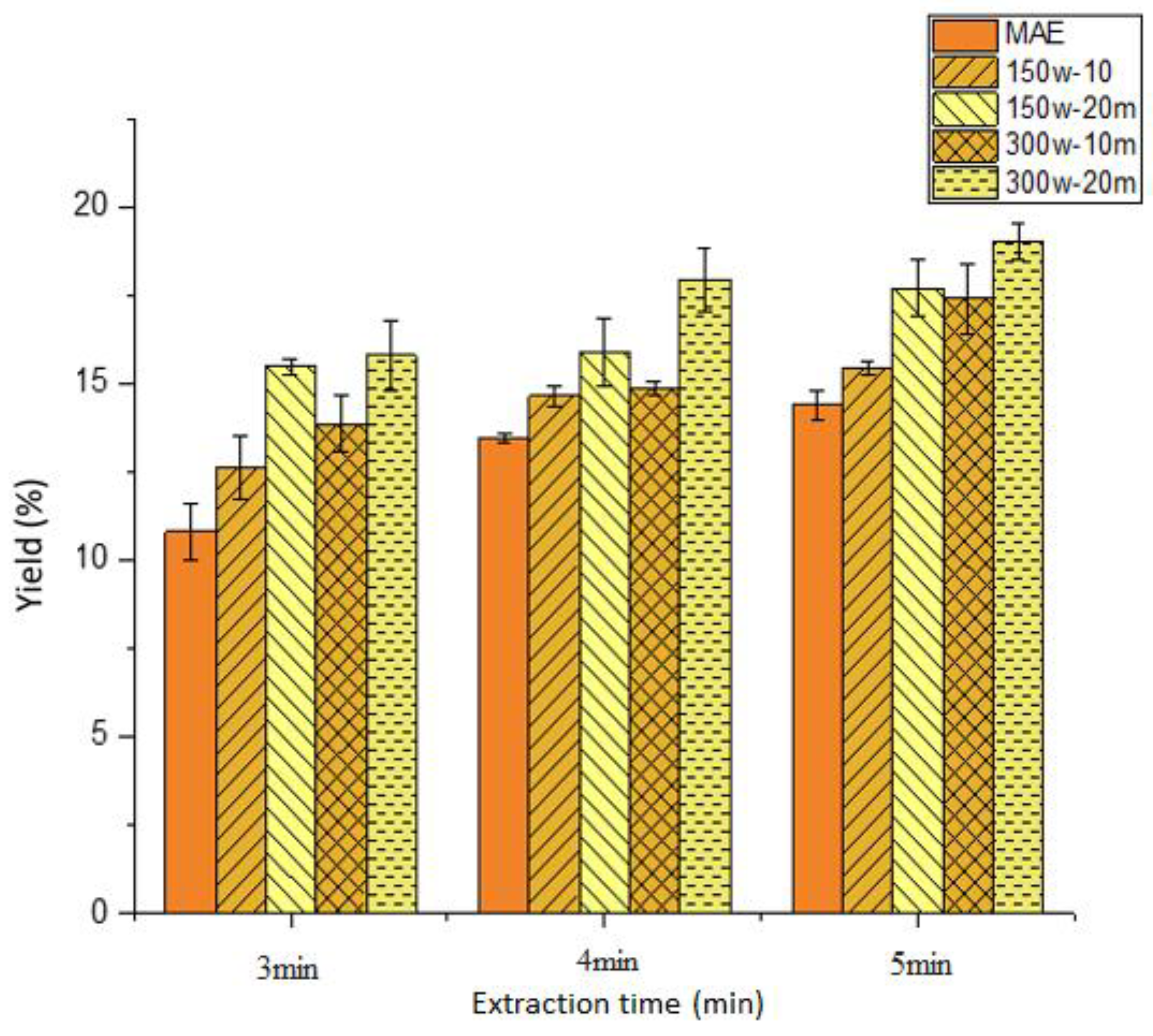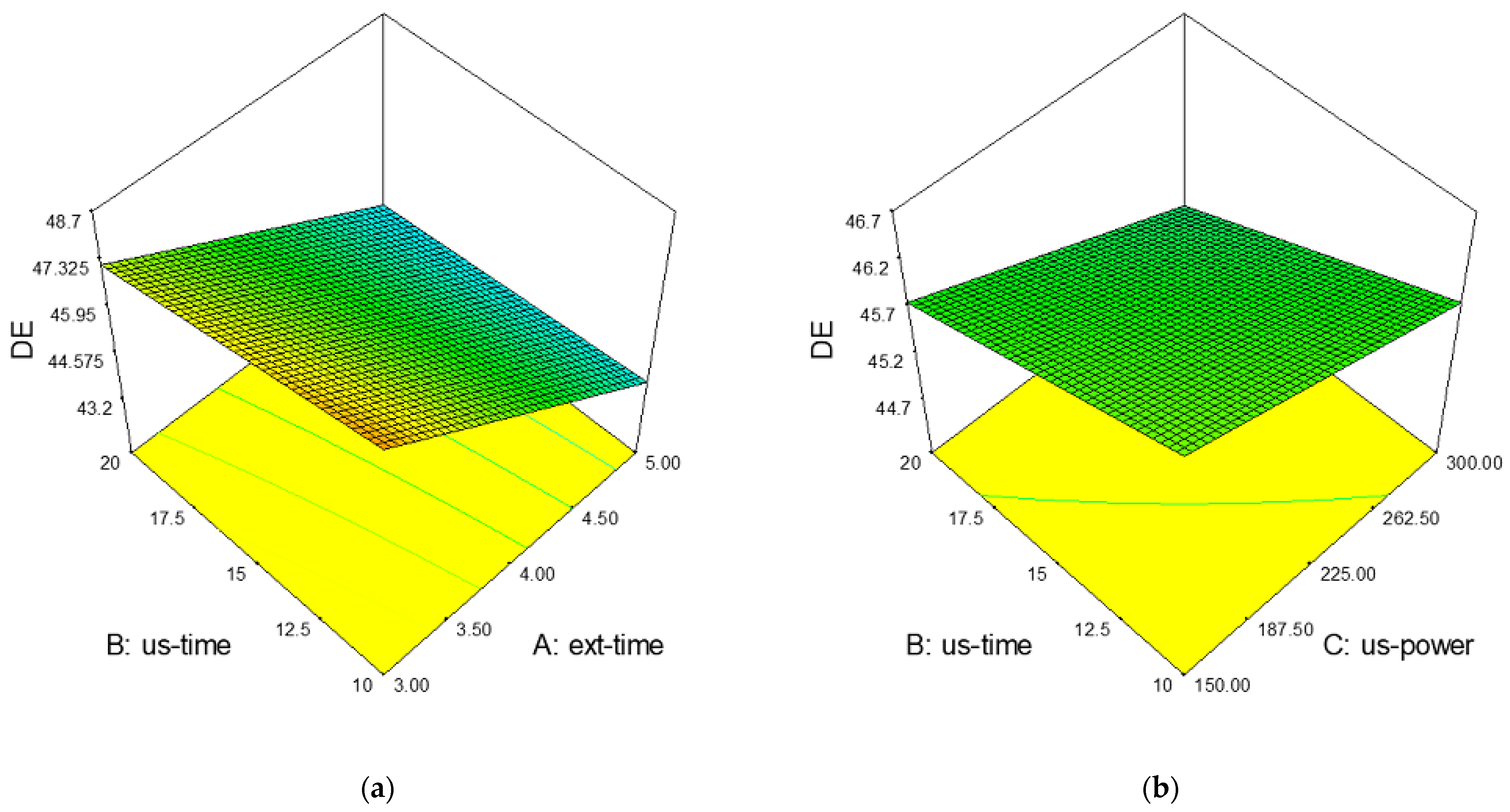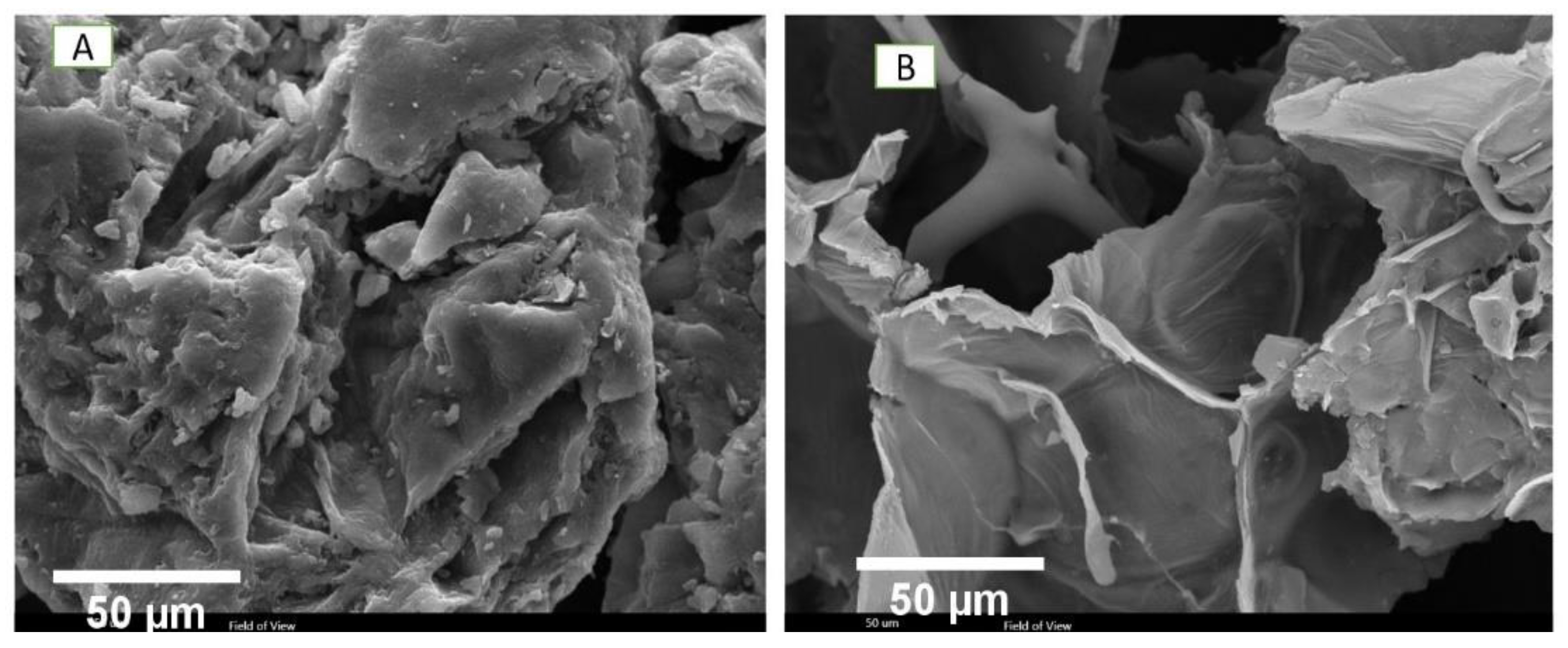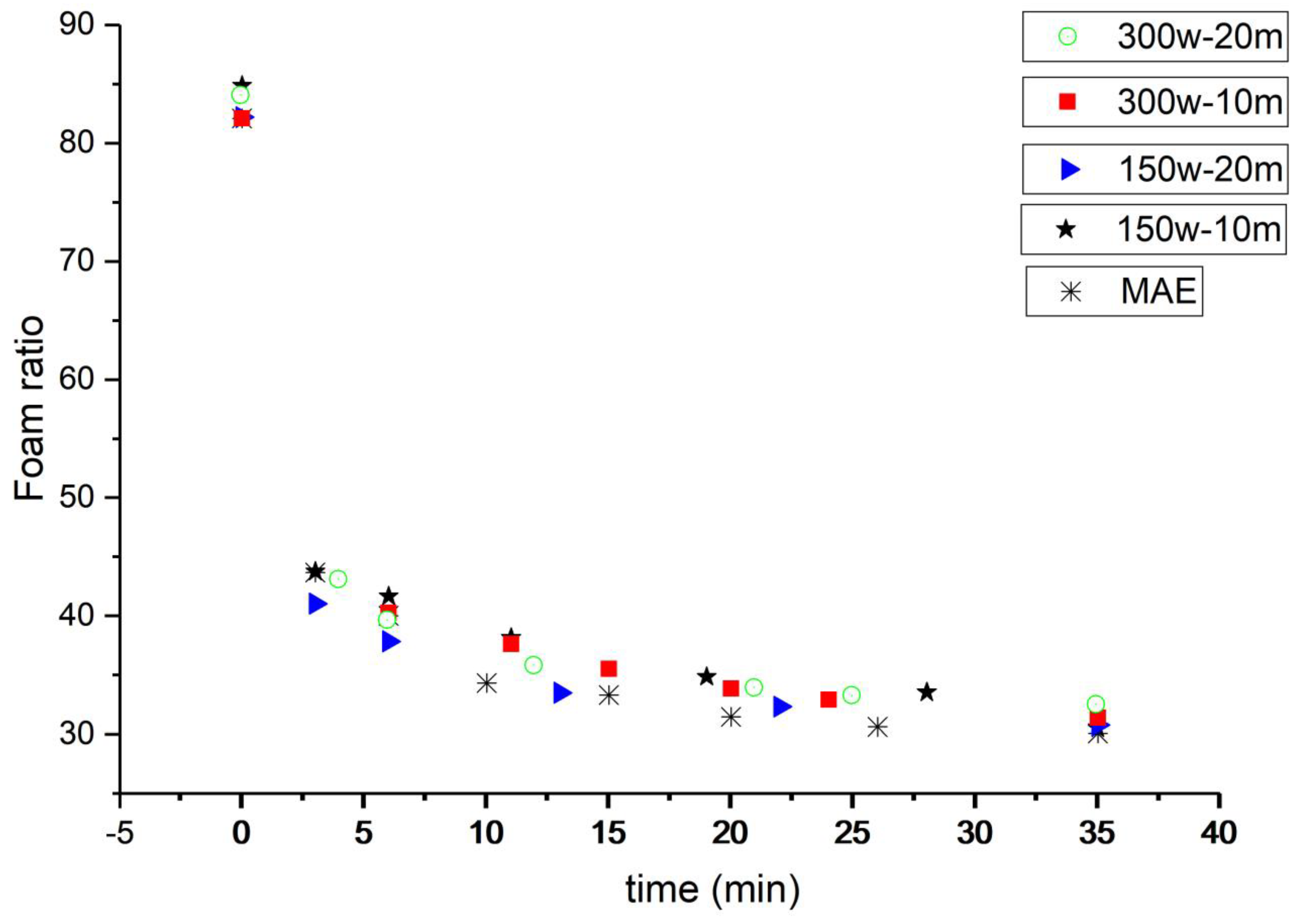The Effect of Ultrasound Pretreatment on Pectin Extraction from Watermelon Rind Using Microwave-Assisted Extraction
Abstract
1. Introduction
2. Materials and Methods
2.1. Sample Preparation
2.2. Pectin Extraction
Ultrasonic Pretreatment
2.3. Microwave-Assisted Extraction
2.4. Morphology of Watermelon Rind Powder
2.5. Pectin Characteristics
2.6. Monosaccharide Composition of Pectin
2.7. Surface Tension and Foaming Properties
2.8. Intrinsic Viscosity and Viscosity Average Molecular Weight
2.9. Colour
2.10. Statistical Analysis
3. Results and Discussion
3.1. Extraction Yield
3.2. Degree of Esterification
3.3. Pectin Compositions (Monosaccharide, Galacturonic Acid Content and Protein Content)
3.4. Morphology of the Watermelon Rind Powder
3.5. Water Holding Capacity and Surface Tension
3.6. Foaming Property
3.7. Intrinsic Viscosity and Viscosity Average Molecular Weight
3.8. Colour Attributes
4. Conclusions
Author Contributions
Funding
Institutional Review Board Statement
Informed Consent Statement
Data Availability Statement
Conflicts of Interest
References
- Food and Agriculture Organization of the United Nations. Available online: http://faostat.fao.org (accessed on 5 April 2023).
- Kumar, P. Watermelon-utilization of peel waste for pickle processing. Indian Food Pack. 1985, 39, 49–52. [Google Scholar]
- Naknaen, P.; Itthisoponkul, T.; Sondee, A.; Angsombat, N. Utilization of watermelon rind waste as a potential source of dietary fiber to improve health promoting properties and reduce glycemic index for cookie making. Food Sci. Biotechnol. 2016, 25, 415–424. [Google Scholar] [CrossRef] [PubMed]
- Wang, W.; Chen, W.; Zou, M.; Lv, R.; Wang, D.; Hou, F.; Feng, H.; Ma, X.; Zhong, J.; Ding, T.; et al. Applications of power ultrasound in oriented modification and degradation of pectin: A review. J. Food Eng. 2018, 234, 98–107. [Google Scholar] [CrossRef]
- Zhang, G.; Zheng, C.; Huang, B.; Fei, P. Preparation of acylated pectin with gallic acid through enzymatic method and their emulsifying properties, antioxidation activities and antibacterial activities. Int. J. Biol. Macromol. 2020, 165, 198–204. [Google Scholar] [CrossRef]
- Naqash, F.; Masoodi, F.; Rather, S.A.; Wani, S.; Gani, A. Emerging concepts in the nutraceutical and functional properties of pectin—A Review. Carbohydr. Polym. 2017, 168, 227–239. [Google Scholar] [CrossRef]
- Kazemi, M.; Khodaiyan, F.; Hosseini, S.S. Eggplant peel as a high potential source of high methylated pectin: Ultrasonic extraction optimization and characterization. LWT 2019, 105, 182–189. [Google Scholar] [CrossRef]
- Rodsamran, P.; Sothornvit, R. Microwave heating extraction of pectin from lime peel: Characterization and properties compared with the conventional heating method. Food Chem. 2019, 278, 364–372. [Google Scholar] [CrossRef]
- Wang, W.; Ma, X.; Jiang, P.; Hu, L.; Zhi, Z.; Chen, J.; Ding, T.; Ye, X.; Liu, D. Characterization of pectin from grapefruit peel: A comparison of ultrasound-assisted and conventional heating extractions. Food Hydrocoll. 2016, 61, 730–739. [Google Scholar] [CrossRef]
- Swamy, G.J.; Muthukumarappan, K. Optimization of continuous and intermittent microwave extraction of pectin from banana peels. Food Chem. 2017, 220, 108–114. [Google Scholar] [CrossRef]
- Sánchez, C.C.; Patino, J.M.R. Interfacial, foaming and emulsifying characteristics of sodium caseinate as influenced by protein concentration in solution. Food Hydrocoll. 2005, 19, 407–416. [Google Scholar] [CrossRef]
- Alves, T.F.R.; Morsink, M.; Batain, F.; Chaud, M.V.; Almeida, T.; Fernandes, D.A.; da Silva, C.F.; Souto, E.B.; Severino, P. Applications of Natural, Semi-Synthetic, and Synthetic Polymers in Cosmetic Formulations. Cosmetics 2020, 7, 75. [Google Scholar] [CrossRef]
- Noreen, A.; Akram, J.; Rasul, I.; Mansha, A.; Yaqoob, N.; Iqbal, R.; Tabasum, S.; Zuber, M.; Zia, K.M. Pectins function-alized biomaterials; a new viable approach for biomedical applications: A review. Int. J. Biol. Macromol. 2017, 101, 254–272. [Google Scholar] [CrossRef] [PubMed]
- Sengar, A.S.; Rawson, A.; Muthiah, M.; Kalakandan, S.K. Comparison of different ultrasound assisted extraction techniques for pectin from tomato processing waste. Ultrason. Sonochemistry 2019, 61, 104812. [Google Scholar] [CrossRef] [PubMed]
- Gonzales-Barron, U.; Butler, F. A comparison of seven thresholding techniques with the k-means clustering algorithm for measurement of bread-crumb features by digital image analysis. J. Food Eng. 2006, 74, 268–278. [Google Scholar] [CrossRef]
- Wai, W.W.; Alkarkhi, A.F.; Easa, A.M. Effect of extraction conditions on yield and degree of esterification of durian rind pectin: An experimental design. Food Bioprod. Process. 2010, 88, 209–214. [Google Scholar] [CrossRef]
- Taylor, K.A.C.C. A colorimetric method for the quantitation of galacturonic acid. Appl. Biochem. Biotechnol. 1993, 43, 51–54. [Google Scholar] [CrossRef]
- Xu, M.; Qi, M.; Goff, H.; Cui, S. Polysaccharides from sunflower stalk pith: Chemical, structural and functional characterization. Food Hydrocoll. 2019, 100, 105082. [Google Scholar] [CrossRef]
- Kazemi, M.; Khodaiyan, F.; Labbafi, M.; Hosseini, S.S.; Hojjati, M. Pistachio green hull pectin: Optimization of microwave-assisted extraction and evaluation of its physicochemical, structural and functional properties. Food Chem. 2019, 271, 663–672. [Google Scholar] [CrossRef]
- Chen, X.; Qi, Y.; Zhu, C.; Wang, Q. Effect of ultrasound on the properties and antioxidant activity of hawthorn pectin. Int. J. Biol. Macromol. 2019, 131, 273–281. [Google Scholar] [CrossRef]
- Nguyen, H.H.D.; Savage, G.P. Properties of Pectin Extracted from Vietnamese Mango Peels. Foods 2019, 8, 629. [Google Scholar] [CrossRef]
- Kratchanova, M.; Pavlova, E.; Panchev, I. The effect of microwave heating of fresh orange peels on the fruit tissue and quality of extracted pectin. Carbohydr. Polym. 2004, 56, 181–185. [Google Scholar] [CrossRef]
- Na Jiang, L.; Shang, J.J.; He, L.B.; Dan, J.M. Comparisons of Microwave-Assisted and Conventional Heating Extraction of Pectin from Seed Watermelon Peel. Adv. Mater. Res. 2012, 550–553, 1801–1806. [Google Scholar] [CrossRef]
- Xu, Y.; Zhang, L.; Bailina, Y.; Ge, Z.; Ding, T.; Ye, X.; Liu, D. Ultrasound-assisted heating extraction of pectin from grapefruit peel: Optimization and comparison with the conventional method. Food Chem. 2015, 178, 106–114. [Google Scholar]
- Gogate, P.R.; Sutkar, V.S.; Pandit, A.B. Sonochemical reactors: Important design and scale up considerations with a special emphasis on heterogeneous systems. Chem. Eng. J. 2011, 166, 1066–1082. [Google Scholar] [CrossRef]
- Kulkarni, S.; Vijayanand, P. Effect of extraction conditions on the quality characteristics of pectin from passion fruit peel (Passiflora edulis f. flavicarpa L.). LWT 2010, 43, 1026–1031. [Google Scholar] [CrossRef]
- Marenda, F.R.B.; Colodel, C.; Canteri, M.H.G.; Müller, C.M.d.O.; Amante, E.R.; Petkowicz, C.L.d.O.; Amboni, R.D.d.M.C. Investigation of cell wall polysaccharides from flour made with waste peel from unripe banana (Musa sapientum) biomass. J. Sci. Food Agric. 2019, 99, 4363–4372. [Google Scholar] [CrossRef]
- Fakayode, O.A.; Abobi, K.E. Optimization of oil and pectin extraction from orange (Citrus sinensis) peels: A response surface approach. J. Anal. Sci. Technol. 2018, 9, 20. [Google Scholar] [CrossRef]
- Denman, L.J.; Morris, G.A. An experimental design approach to the chemical characterisation of pectin polysaccharides extracted from Cucumis melo Inodorus. Carbohydr. Polym. 2015, 117, 364–369. [Google Scholar] [CrossRef]
- Ogutu, F.O.; Mu, T.-H. Ultrasonic degradation of sweet potato pectin and its antioxidant activity. Ultrason. Sonochemistry 2017, 38, 726–734. [Google Scholar] [CrossRef]
- Petkowicz, C.; Vriesmann, L.; Williams, P. Pectins from food waste: Extraction, characterization and properties of watermelon rind pectin. Food Hydrocoll. 2017, 65, 57–67. [Google Scholar] [CrossRef]
- Popper, Z.; Fry, S.C. Widespread occurrence of a covalent linkage between xyloglucan and acidic polysaccharides in suspension-cultured angiosperm cells. Ann. Bot. 2005, 96, 91–99. [Google Scholar] [CrossRef] [PubMed]
- Broxterman, S.E.; Schols, H.A. Interactions between pectin and cellulose in primary plant cell walls. Carbohydr. Polym. 2018, 192, 263–272. [Google Scholar] [CrossRef] [PubMed]
- Naghshineh, M.; Olsen, K.; Georgiou, C. Sustainable production of pectin from lime peel by high hydrostatic pressure treatment. Food Chem. 2013, 136, 472–478. [Google Scholar] [CrossRef] [PubMed]
- Cortés-Camargo, S.; Román-Guerrero, A.; Alpizar-Reyes, E.; Pérez-Alonso, C. New Sources of Pectin: Extraction, Processing, and Industrial Applications; InTech Open: London, UK, 2023. [Google Scholar] [CrossRef]
- Rubio-Senent, F.; Rodríguez-Gutiérrez, G.; Lama-Muñoz, A.; Fernández-Bolaños, J. Pectin extracted from thermally treated olive oil by-products: Characterization, physico-chemical properties, in vitro bile acid and glucose binding. Food Hydrocoll. 2015, 43, 311–321. [Google Scholar] [CrossRef]
- Elleuch, M.; Bedigian, D.; Roiseux, O.; Besbes, S.; Blecker, C.; Attia, H. Dietary fibre and fibre-rich by-products of food processing: Characterisation, technological functionality and commercial applications: A review. Food Chem. 2011, 124, 411–421. [Google Scholar] [CrossRef]
- Karaman, S.; Kesler, Y.; Goksel, M.; Dogan, M.; Kayacier, A. Rheological and some Physicochemical Properties of Selected Hydrocolloids and their Interactions with Guar Gum: Characterization using Principal Component Analysis and Viscous Synergism Index. Int. J. Food Prop. 2014, 17, 1655–1667. [Google Scholar] [CrossRef]
- Mitura, S.; Sionkowska, A.; Jaiswal, A. Biopolymers for hydrogels in cosmetics. J. Mater. Sci. Mater. Med. 2020, 31, 1–14. [Google Scholar] [CrossRef]
- Kitabatake, N.; Doi, E. Surface Tension and Foaming of Protein Solutions. J. Food Sci. 1982, 47, 1218–1221. [Google Scholar] [CrossRef]
- Schmidt, U.S.; Koch, L.; Rentschler, C.; Kurz, T.; Endreß, H.U.; Schuchmann, H.P. Effect of Molecular Weight Reduction, Acetylation and Esterification on the Emulsification Properties of Citrus Pectin. Food Biophys. 2014, 10, 217–227. [Google Scholar] [CrossRef]
- Martínez, K.D.; Sánchez, C.C.; Patino, J.M.R.; Pilosof, A.M. Interfacial and foaming properties of soy protein and their hydrolysates. Food Hydrocoll. 2009, 23, 2149–2157. [Google Scholar] [CrossRef]
- Kpodo, F.M.; Agbenorhevi, J.K.; Alba, K.; Oduro, I.N.; Morris, G.A.; Kontogiorgos, V. Structure-Function Relationships in Pectin Emulsification. Food Biophys. 2018, 13, 71–79. [Google Scholar] [CrossRef] [PubMed]
- Basak, S.; Annapure, U.S. Atmospheric pressure pin-to-plate cold plasma modification of high methoxyl apple pectin: Impact on functional properties. J. Agric. Food Res. 2022, 9, 100356. [Google Scholar] [CrossRef]
- Khubber, S.; Kazemi, M.; Samani, S.A.; Lorenzo, J.M.; Simal-Gandara, J.; Barba, F.J. Structural-functional Variability in Pectin and Effect of Innovative Extraction Methods: An Integrated Analysis for Tailored Applications. Food Rev. Int. 2021, 39, 1–26. [Google Scholar] [CrossRef]
- Xu, S.-Y.; Liu, J.-P.; Huang, X.; Du, L.-P.; Shi, F.-L.; Dong, R.; Huang, X.-T.; Zheng, K.; Liu, Y.; Cheong, K.-L. Ultrasonic-microwave assisted extraction, characterization and biological activity of pectin from jackfruit peel. LWT 2018, 90, 577–582. [Google Scholar] [CrossRef]
- Ma, X.; Wang, D.; Chen, W.; Ismail, B.B.; Wang, W.; Lv, R.; Ding, T.; Ye, X.; Liu, D. Effects of ultrasound pretreatment on the enzymolysis of pectin: Kinetic study, structural characteristics and anti-cancer activity of the hydrolysates. Food Hydrocoll. 2018, 79, 90–99. [Google Scholar] [CrossRef]
- Bagherian, H.; Ashtiani, F.Z.; Fouladitajar, A.; Mohtashamy, M. Comparisons between conventional, microwave-and ultrasound-assisted methods for extraction of pectin from grapefruit. Chem. Eng. Process. Process Intensif. 2011, 50, 1237–1243. [Google Scholar] [CrossRef]




| MAE | MAUPE | ||||
|---|---|---|---|---|---|
| 150 W–10 min | 150 W–20 min | 300 W–10 min | 300 W–20 min | ||
| Rhamnose (%) | 0.29 | 0.47 | 0.41 | 0.39 | 0.31 |
| Arabinose (%) | 0.55 | 0.70 | 0.65 | 0.86 | 0.77 |
| Galactose (%) | 3.28 | 6.04 | 3.85 | 6.01 | 5.51 |
| Glucose (%) | 2.50 | 3.23 | 2.95 | 3.28 | 4.82 |
| Xylose (%) | 0.13 | 0.15 | 0.18 | 0.12 | 0.15 |
| Galacturonic acid (%) | 73.5 | 72.5 | 71.6 | 70.0 | 69.5 |
| HM (%) | 73.40 | 72.08 | 71.19 | 69.51 | 69.19 |
| RG-I (%) | 4.37 | 7.68 | 5.32 | 7.64 | 6.92 |
| R1 (%) | 31.10 | 24.66 | 25.85 | 23.53 | 15.79 |
| Protein (%) | 5.84 | 8.22 | 8.57 | 8.37 | 8.81 |
| MAE | MAUPE | ||||
|---|---|---|---|---|---|
| 0 W | 150 W–10 min | 150 W–20 min | 300 W–10 min | 300 W–20 min | |
| Surface tension | 45.75 ± 0.21 b | 45.5 ± 0.14 b | 44.6 ± 0.28 a | 44.4 ± 0.28 a | 44.2 ± 0.20 a |
| WHC | 12.43 ± 0.19 b | 11.95 ± 0.32 ab | 11.94 ± 0.5 ab | 11.97 ± 0.27 ab | 11.72 ± 0.30 a |
| FC | 81.5 ± 0.7 a | 83.9 ± 0.5 ab | 86.3 ± 0.8 bc | 86.5 ± 0.8 bc | 87.25 ± 0.7 c |
| FS | 30.0 ± 0.8 a | 30.5 ± 0.7 ab | 31.2 ± 1.2 b | 31.8 ± 0.7 b | 31.5 ± 0.9 b |
| MAE | MAUPE | ||||
|---|---|---|---|---|---|
| 150 W–10 min | 150 W–20 min | 300 W–10 min | 300 W–20 min | ||
| a | 82.56 | 85.12 | 86.43 | 86.5 | 86.98 |
| k | 37.04 | 37.24 | 39.52 | 37.91 | 39.47 |
| t1/2 | 2.78 | 3.69 | 2.49 | 3.73 | 2.64 |
| R2 | 0.99 | 0.99 | 0.99 | 0.99 | 0.99 |
| RMSE | 1.135 | 0.68 | 0.86 | 0.52 | 1.06 |
| MAE | MAUPE | ||||
|---|---|---|---|---|---|
| 0 W | 150 W–10 min | 150 W–20 min | 300 W–10 min | 300 W–20 min | |
| Intrinsic viscosity (mL/g) | 37.7 ± 0.3 b | 33.1 ± 0.3 b | 29.6 ± 0.4 a | 30.4 ± 0.3 a | 28.9 ± 0.4 a |
| Mw (KDa) | 322.8 ± 2.0 b | 318.1 ± 2.3 b | 292.8 ± 2.7 a | 298.1 ± 2.1 a | 287.2 ± 2.7 a |
| MAE | MAUPE | ||||
|---|---|---|---|---|---|
| 150 W–10 min | 150 W–20 min | 300 W–10 min | 300 W–20 min | ||
| L* | 66.4 ± 0.2 b | 62.5 ± 1.0 a | 62.4 ± 0.5 a | 60.6 ± 0.2 a | 61.1 ± 0.2 a |
| a* | 0.3 ± 0.06 a | 0.2 ± 0.1 a | 0.7 ± 0.2 a | 0.4 ± 0.2 a | 0.7 ± 0.1 a |
| b* | 17.3 ± 0.7 a | 18.4 ± 0.5 a | 18.6 ± 0.8 a | 22.3 ± 0.8 b | 25.3 ± 0.7 b |
| ΔE | - | 4.05 | 4.22 | 7.65 | 9.60 |
Disclaimer/Publisher’s Note: The statements, opinions and data contained in all publications are solely those of the individual author(s) and contributor(s) and not of MDPI and/or the editor(s). MDPI and/or the editor(s) disclaim responsibility for any injury to people or property resulting from any ideas, methods, instructions or products referred to in the content. |
© 2023 by the authors. Licensee MDPI, Basel, Switzerland. This article is an open access article distributed under the terms and conditions of the Creative Commons Attribution (CC BY) license (https://creativecommons.org/licenses/by/4.0/).
Share and Cite
Forouhar, A.; Hamdami, N.; Djelveh, G.; Gardarin, C.; Pierre, G.; Ursu, A.V.; Michaud, P. The Effect of Ultrasound Pretreatment on Pectin Extraction from Watermelon Rind Using Microwave-Assisted Extraction. Appl. Sci. 2023, 13, 5558. https://doi.org/10.3390/app13095558
Forouhar A, Hamdami N, Djelveh G, Gardarin C, Pierre G, Ursu AV, Michaud P. The Effect of Ultrasound Pretreatment on Pectin Extraction from Watermelon Rind Using Microwave-Assisted Extraction. Applied Sciences. 2023; 13(9):5558. https://doi.org/10.3390/app13095558
Chicago/Turabian StyleForouhar, Ali, Nasser Hamdami, Gholamreza Djelveh, Christine Gardarin, Guillaume Pierre, Alina Violeta Ursu, and Philippe Michaud. 2023. "The Effect of Ultrasound Pretreatment on Pectin Extraction from Watermelon Rind Using Microwave-Assisted Extraction" Applied Sciences 13, no. 9: 5558. https://doi.org/10.3390/app13095558
APA StyleForouhar, A., Hamdami, N., Djelveh, G., Gardarin, C., Pierre, G., Ursu, A. V., & Michaud, P. (2023). The Effect of Ultrasound Pretreatment on Pectin Extraction from Watermelon Rind Using Microwave-Assisted Extraction. Applied Sciences, 13(9), 5558. https://doi.org/10.3390/app13095558








